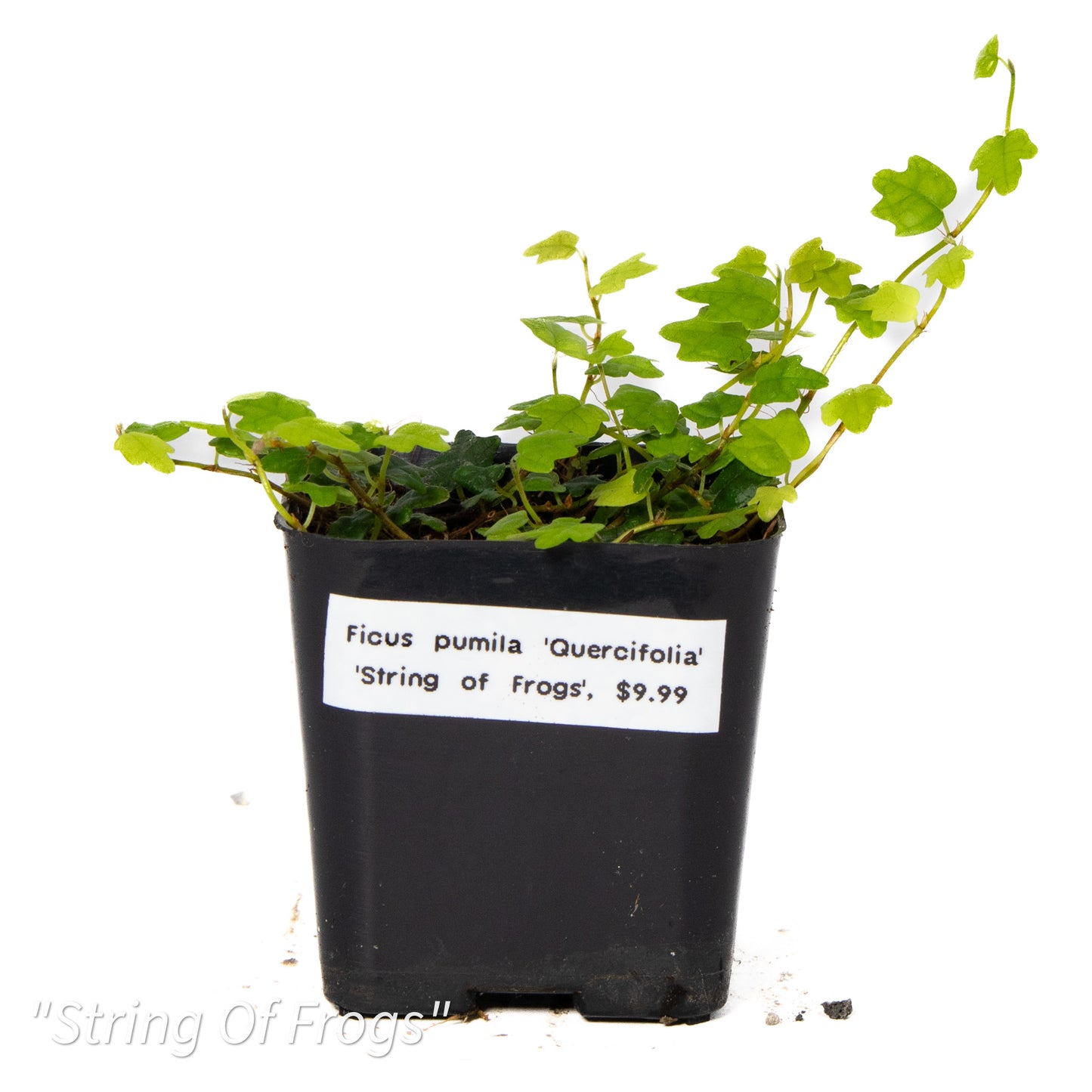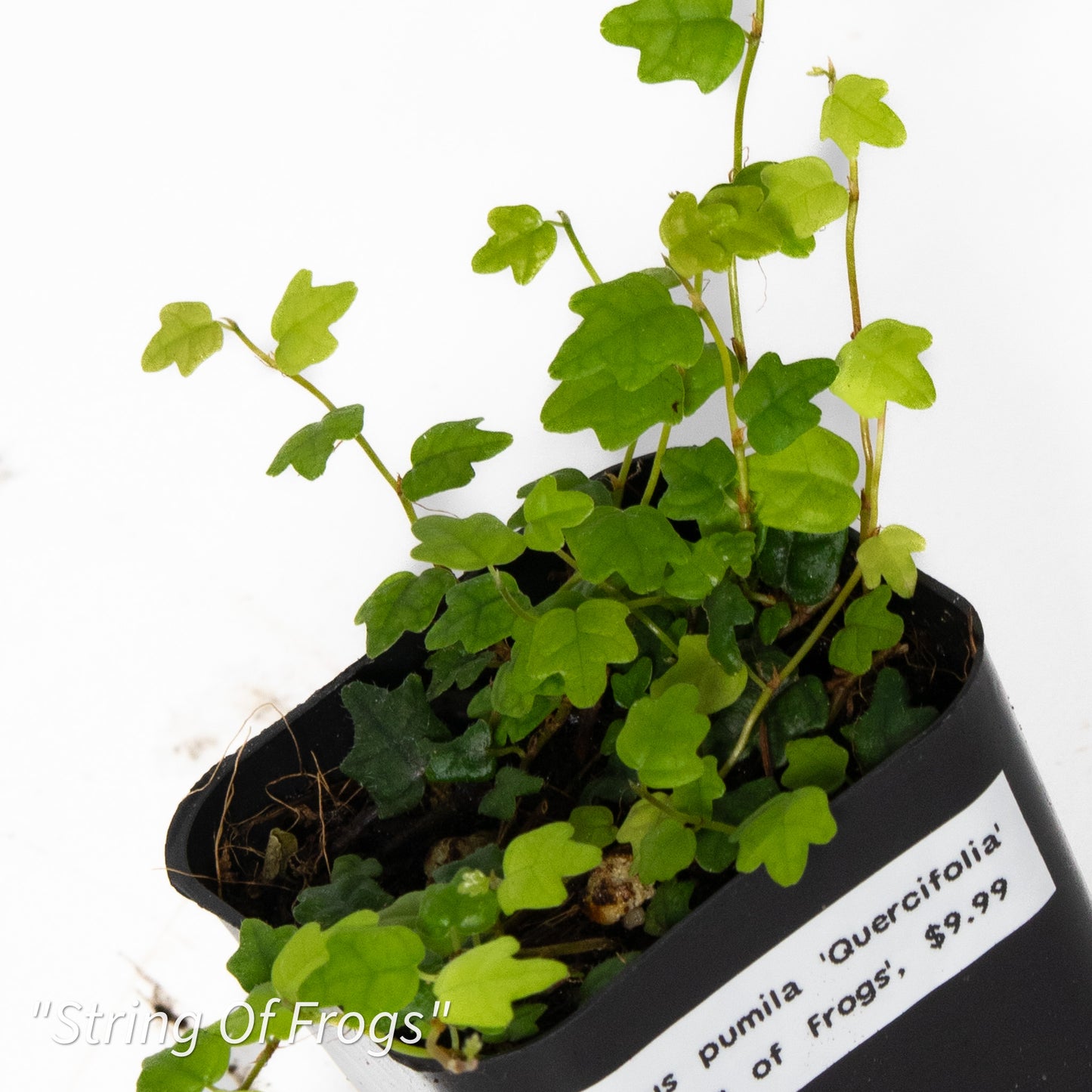Royal Python's Cove
Ficus pumila ‘Quercifolia’ ‘String of Frogs’
Ficus pumila ‘Quercifolia’ ‘String of Frogs’
Couldn't load pickup availability
Ficus pumila ‘Quercifolia’, commonly known as ‘String of Frogs’, is a miniature trailing vine named for its tiny, lobed leaves that resemble little frog silhouettes. This fast-growing, creeping plant is ideal for bioactive enclosures, where it provides ground cover, climbing foliage, and humidity retention. Its delicate yet resilient nature makes it perfect for terrariums, vivariums, and paludariums.
Care Instructions
LIGHT. Prefers bright, indirect light but can tolerate lower light levels. In bioactive setups, place it near a light source to encourage healthy growth and maintain its compact, dense foliage. Avoid direct sunlight, which can scorch the delicate leaves.
SOIL. Thrives in a moist, well-draining soil mix rich in organic material. A blend of coconut coir, orchid bark, and perlite supports healthy root development and mimics its natural habitat. In bioactive enclosures, this soil mix also provides an ideal environment for decomposers like isopods and springtails.
WATERING. Keep the soil consistently moist but not soggy. Allow the top half-inch of soil to dry out slightly between waterings. In a bioactive setup, the presence of springtails and isopods helps regulate moisture levels and prevent overwatering issues.
HUMIDITY. Requires high humidity (above 70%) to thrive, making it an excellent choice for humid bioactive setups. If humidity is too low, the leaves may dry out and become brittle. Misting or adding a water dish in the enclosure can help maintain ideal moisture levels.
TEMPERATURE. Prefers warm temperatures between 65°F and 85°F (18°C to 29°C). Avoid exposure to cold drafts or temperatures below 55°F (13°C), which can cause growth to slow or leaves to drop.
FERTILIZATION. Feed with a diluted balanced liquid fertilizer every 4-6 weeks during the growing season (spring and summer). In bioactive enclosures, organic fertilizers like Mealworm Frass provide slow-release nutrients, promoting healthy, lush growth. Reduce feeding in winter when growth naturally slows.
Cohabitation with Bioactive Organisms
ISOPODS. These beneficial decomposers break down organic matter, keeping the substrate nutrient-rich and preventing soil compaction, which helps the plant’s root system thrive.
SPRINGTAILS. Essential for preventing mold and fungal growth, springtails thrive in the humid conditions that Ficus pumila ‘Quercifolia’ loves, ensuring a clean and balanced environment.
Soil and Maintenance Tips
SUBSTRATE. A well-draining, nutrient-rich mix of coconut coir, orchid bark, and perlite ensures strong root development while preventing excess moisture buildup. A thin layer of activated charcoal at the base helps filter impurities and control odors in bioactive setups.
HUMIDITY CONTROL. Misting the enclosure, using a water feature, or maintaining a humid microclimate ensures optimal conditions. Springtails and isopods help regulate excess moisture and keep the environment healthy.
TRIMMING. Regular pruning helps maintain a compact growth habit and prevents it from overcrowding other plants. Cuttings can be easily propagated in water or directly in soil.
PEST CONTROL. Naturally resistant to most pests, but watch for aphids and spider mites in drier conditions. The presence of isopods and springtails helps keep pest populations in check naturally.
With its charming, frog-shaped leaves and ability to thrive in humid environments, Ficus pumila ‘Quercifolia’ (‘String of Frogs’) is a perfect addition to bioactive setups. Its dense, trailing vines create a lush, natural aesthetic while supporting a balanced ecosystem with isopods and springtails. By providing the right humidity, light, and substrate, this adorable creeping plant will flourish, enhancing the biodiversity and visual appeal of your terrarium or vivarium.
Share




